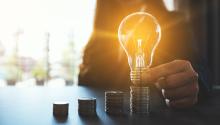Making an impact with next-gen Giorgio Sella

Since the late 16th-Century, Italy’s famed Sella family have been leaders in the textile industry – so much so, that in 1817, the family introduced the first Italian mechanized wool mill helping to spark the country’s industrial revolution. Two generations later, the formation of Banca Sella solidified the family’s reputation.
Now, 11th-generation family member Giorgio Sella, with the support of his parents, is making his own mark having spent the past ten years funding and supporting a sustainable and highly efficient power source in the shape of Kitenergy, a project that can generate alternative energy from high-altitude winds.
Having completed a BSc Business and Economics degree course at the University of Buckingham, the next-gen is now exploring the full potential of an impact investment that could change the lives of people living in, amongst others, less-densely inhabited areas of the world.
Silicon Valley Bank and Campden Wealth’s report, Family Offices Investing in Venture Capital, found that 79% of family offices are making venture investments in impact-focused funds and start-ups. 64% indicated climate change as an area of interest and next-gens are at the forefront of this push for ethical investment.
Here, Giorgio tells Campden FB about his legacy and why he thinks Kitenergy has the potential to create significant change…
My family has a long history of industrial activities and it is a great legacy of which I am very respectful. There is a never-ending source of examples and moral codes that have driven generation after generation. This instils in me, a sense of responsibility to match the achievements of those who have gone before me.
At some point, the possibility came for me to do something in parallel with the family activities. This was Kitenergy, an Italian start-up founded in 2010 with the aim to generate renewable energy from high-altitude winds.
Why did I choose it? I very much liked the concept of creating and giving truly sustainable energy where it wasn’t available before. We found out that it makes sense for lots of people and places. There is a strong demand, albeit not for all markets.
When we started ten years ago, I didn't categorize this as an impact investment. We just wanted to create a machine that provided green energy with great accessibility. The machine is very easy to deploy. You don't need roads or the energy grid, the installation is fast and it offers a great range of flexibility.
In the beginning the company was little more than a white paper. The attention and focus on sustainable energy and the goals to reduce carbon footprint and CO2 emissions were just nice intentions, without the attention and care the renewable energy sector has developed today. Ten years ago, in our specific case, the sector of high-altitude wind energy consisted of a few studies and very little machines and validation. Now, we and the industry are going towards the final stage of the research and I see the sector that is rapidly emerging with 30 companies and 100 research institutions globally.
The high-altitude winds blowing at a consistently high speed represent an energy source that is larger than the world’s current energy needs. In the US, for example, the potential of energy producible with this generator is far greater than the current energy demand (National Renewable Energy Laboratory, 2021).
The technical concept is that the wing, (kite) flies on an autonomous base and is connected to the ground with cables, that have the function to drive the wing and to transfer the torque developed in the air by the kite to the ground onto cylinders that spin for the length of the cables. The cylinders are connected to electric engines that generate electricity.
The control of the kites is done through software that receives data at a high sample rate by the avionic devices and the data collected is used in real time to control the flight trajectories of the kite.
We aim to validate the potential of our machine and we are confident that the power output we calculated will be demonstrated within the next 12 months.
The device has the power output to bring green power to some environments that today are relying solely on fossil energy or where there is no energy availability at all. This technology has the potential of generating renewable energy at a high efficiency rate. If you consider that solar and wind efficiency averages from 20% to 40%, our system has 60+% efficiency. On top of this, the machine requires little energy to be manufactured and disposed, minimising the carbon footprint of the lifecycle of the product.






